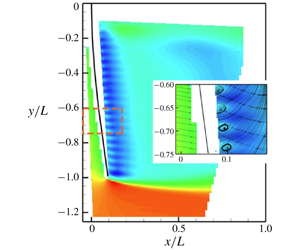Article contents
On the distinct drag, reconfiguration and wake of perforated structures
Published online by Cambridge University Press: 02 March 2020
Abstract

Using especially designed laboratory experiments, we demonstrate that the flow-driven deformation of sufficiently porous, wall-mounted, flexible plates can exhibit positive Vogel exponent  $V$, i.e. drag proportional to the
$V$, i.e. drag proportional to the  $(2+V)$ power of the incoming flow velocity. High-resolution force balance, planar particle image velocimetry and particle tracking velocimetry are used to measure the drag force, flow characteristics and plate bending. For a flexible plate with relatively high porosity given by an array of regularly spaced square openings, we derive a simple analytical argument that accounts for the sub-quadratic trends of the drag in a range of flow velocities spanning one order of magnitude. There, the drag experienced by the structure is modulated by the contributions of the local structure containing an open area. The effective approach velocity for each of these sections appears to increase monotonically with increased structure deformation due to the reduced effect of local wakes produced by adjacent areas. The uncovered aerodynamic behaviour may help to understand the complex flow–structure interaction of perforated structures in nature and engineering.
$(2+V)$ power of the incoming flow velocity. High-resolution force balance, planar particle image velocimetry and particle tracking velocimetry are used to measure the drag force, flow characteristics and plate bending. For a flexible plate with relatively high porosity given by an array of regularly spaced square openings, we derive a simple analytical argument that accounts for the sub-quadratic trends of the drag in a range of flow velocities spanning one order of magnitude. There, the drag experienced by the structure is modulated by the contributions of the local structure containing an open area. The effective approach velocity for each of these sections appears to increase monotonically with increased structure deformation due to the reduced effect of local wakes produced by adjacent areas. The uncovered aerodynamic behaviour may help to understand the complex flow–structure interaction of perforated structures in nature and engineering.
- Type
- JFM Papers
- Information
- Copyright
- © The Author(s), 2020. Published by Cambridge University Press
References
- 14
- Cited by


